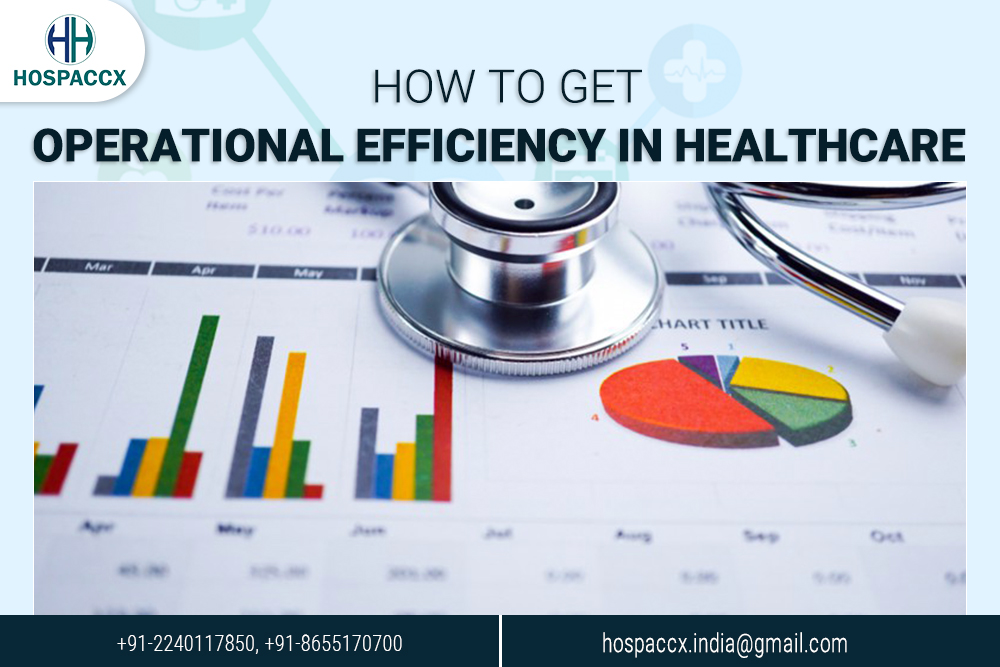HOW TO GET OPERATIONAL EFFICIENCY IN HEALTHCARE
INTRODUCTION
Efficient operation of healthcare is one of the major concern areas for the management team of any organisation as it involves multiple departments, numerous activities, intertwined processes and involvement of staff at different levels and more importantly efficient use of scarce resources.
Operational processes are in play that support and facilitate human performance and reduce risk of error. These processes have associated metrics that indicate how successful a given process is, how successful the human using that process is, and where there are opportunities for improvement
Considering the above facts, Hospaccx team work on the market trends and dynamic regarding operational efficiency in healthcare. This is macroficial study of How to get Operational Efficiency in Healthcare, if you want to get into more detail you can contact info@hhbc.in
WAYS FOR EFFICIENCY IN HEALTHCARE OPERATIONS
There are four simple ways to reach administrative and operational efficiency:
Efficiency of Process incorporates the planning and operational practices that significantly reduce or eliminate the negative impact on clinical service continuity in healthcare facilities.
Efficient people can make the most important difference to cost and quality of healthcare facility management service delivery.
Efficiency of technology and end-users’ adoption are key success factors. The challenge remains to balance cost and complexity in implementation of intelligent solutions with a measurable performance output and ROI (Return On Investment) by choosing the appropriate technology to deliver the right process with an optimal utilization level.
Efficiency of solutions implementation implies the decision to implement the right solution in the right place, at the right time, for the right outcome. An efficient implementation will support all other key considerations discussed thus far, providing demonstrable ways to meet business objectives, offering ease-of-use for all stakeholders and providing an environment that supports people-centric processes with near-term ROI.
INFUSING TECHNOLOGY INTO HEALTHCARE OPERATIONAL DECISION MAKING
- EHR (Electronic Health Record) Systems
EHRs give clinicians a comprehensive, real-time view of a patient’s medical history, including diagnoses, medications, treatments plans, immunizations, allergies and test results. EHRs are more than mere digital patient logs that improve clinical documentation and access to patient data; they connect clinical modules across the hospital or health network to improve coordination of care, appointment-scheduling and billing. EHRs have been instrumental in reducing medical errors, improving patient safety and increasing reimbursements.
- Bed Management Systems
Bed management systems coordinate the communication and resource support of a patient’s journey through the hospital. Clinicians use these systems to manage the placement of patients in real time across a health system. They help administrators maximize access by improving flow, reducing length of stay and managing capacity.
- Advanced Analytics
Overcoming data challenges and harnessing information in the various discrete IT silos has driven an immense interest in big data, advanced analytics, machine learning and artificial intelligence. Through the power of predictive and prescriptive analytics, healthcare leaders can use an integrated dataset compiled from existing IT systems to make staffing and capacity decisions that improve operating performance.
OPERATIONAL EFFICIENCY POINTS TO IMPROVE THE PATIENT HAND-OFF
1) Establish an Order of Operations for Documentation
The hospital’s emergency department should have an established policy and procedure for obtaining and recording the required patient documentation otherwise, inefficiencies occur.
2) Keep All Documentation in One Place
Develop one area of documentation in the EMR to gather routine information that’s used consistently from department to department, such as DOB and living will status, as well as past medical history (allergies, home medications, reported problems and procedures). This way, all users know where to find patient information quickly.
3) Develop One Hand-Off Procedure to be Used Hospital-Wide
In this procedure, both the reporting and receiving nurse should deliver the hand-off report at the patient’s bedside with the EMR in front of them. As the nurse performs a verbal SBAR (Situation, Background, Assessment, and Recommendation) and cross-references the information in the EMR, everyone can review the documentation together to make sure it is complete and accurate.
4) Keep the Patient Involved
Involving the patient in the hand-off process gives them an opportunity to fill in any “gaps” in communication and be more involved in their own care. The staff perform their reports with each patient to involve them more fully in the process and strengthen the lines of communication.
5) Monitor and Continuously Improve the Process
Implement an auditing process to ensure that documentation is completed effectively on a consistent basis. This would include reviewing the charts of admitted patients to see when the documentation was performed and whether or not the process was followed. Be sure to re-educate the staff as needed if deviations from the established process occur.
6) Go Fully Electronic
Many hospitals still use a paper for patient documentation – and not because of any EHR limitation, but because the staff prefers the familiarity of it. Often, this information doesn’t get entered into the EMR (to allow universal access for all caregivers) or isn’t transcribed correctly. Eliminating this data gap is critical.
Once a facility takes the necessary steps to refine its workflow process, the next priority is to make the patient hand-off and patient care documentation completely electronic. This allows end users to locate patient documentation more easily and provide better care for patients.
CONCLUSION
Operational efficiency can turn the hospital or clinic into a profitable healthcare facility. It most certainly need undivided attention, hence this would help in achieving perfection & financial stability in a healthcare.
Do you want to make your healthcare organisation operation efficient?
We can help you manage your day to day functioning of the healthcare, from inventory management to equipment planning and maintenance, HR management, business development promotions, TPA Management and management of all other facilities. Operation of all medical and non-medical functions related to the Patient-oriented, value-based activities which are essential for healthcare to run successfully.
It is the superficial and macro level study for more details kindly contact Hospaccx Healthcare business consulting Pvt. ltd on hospaccx.india@gmail.com Or you can visit our website on hospaccxconsulting.com
Related Team Members

















